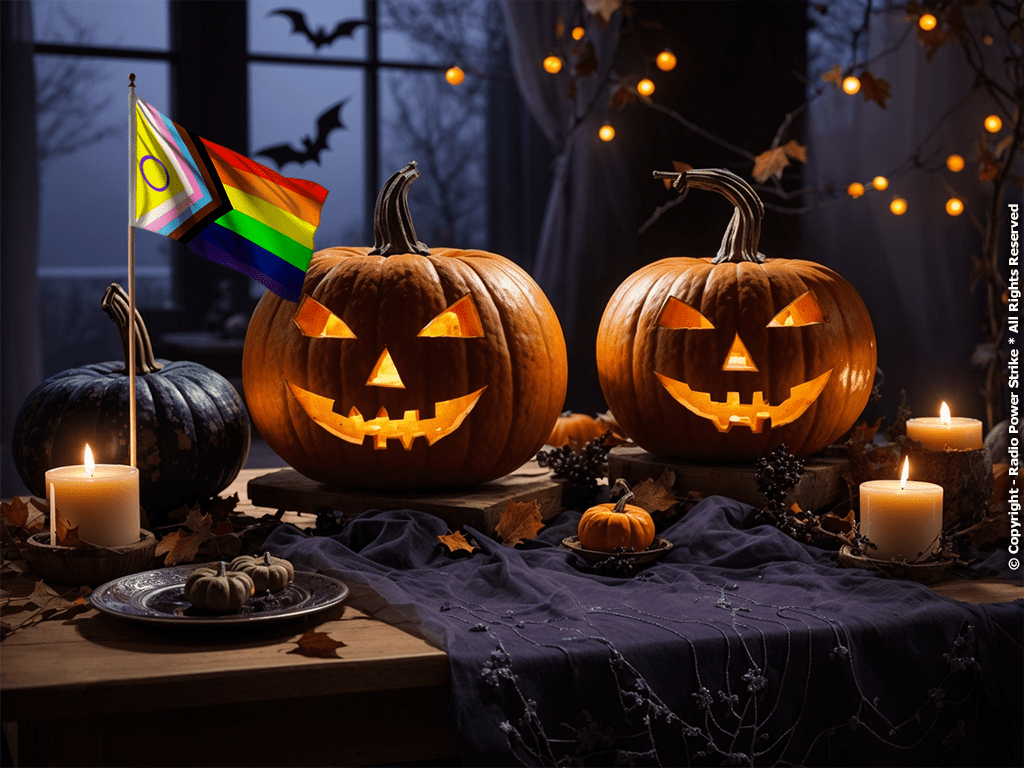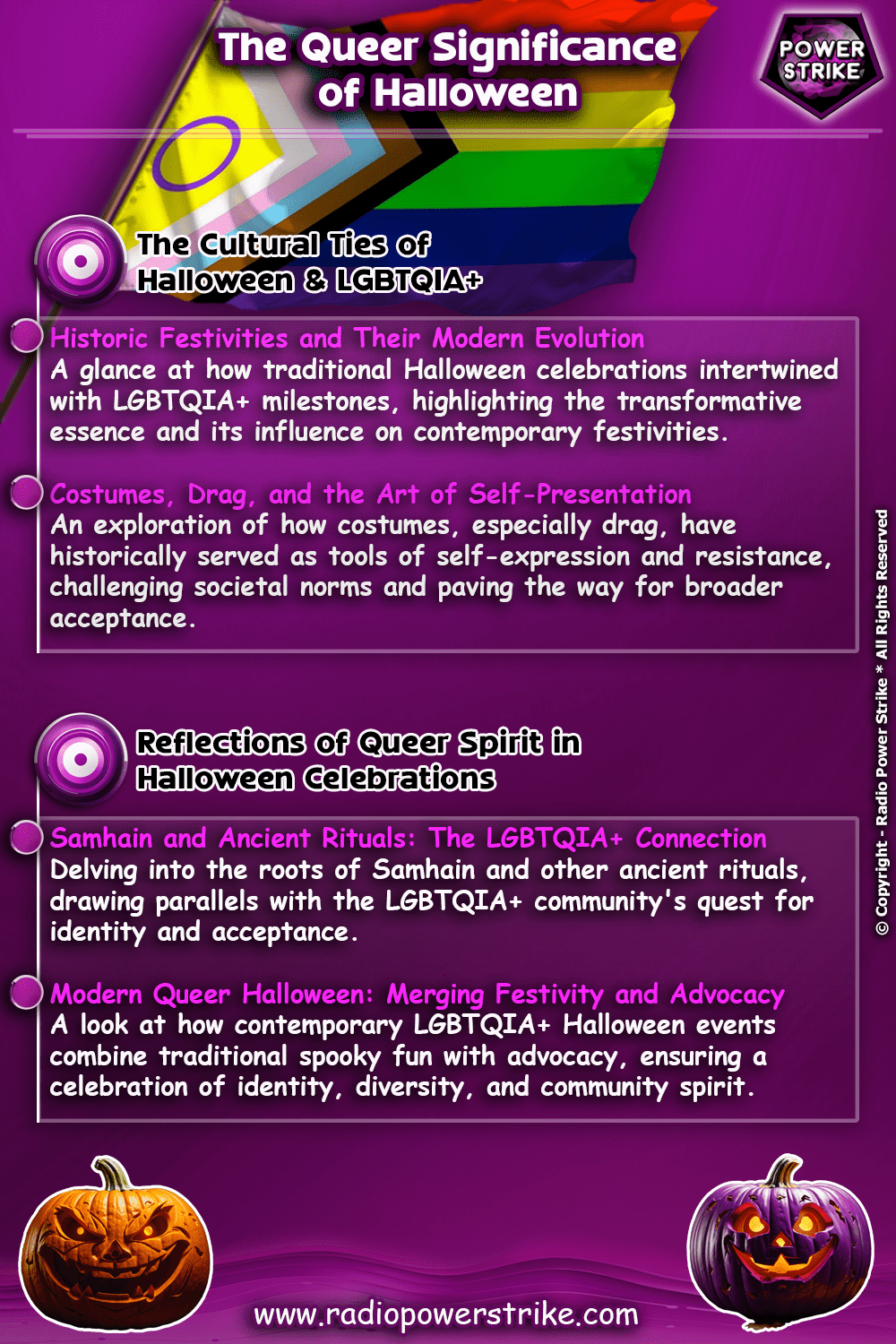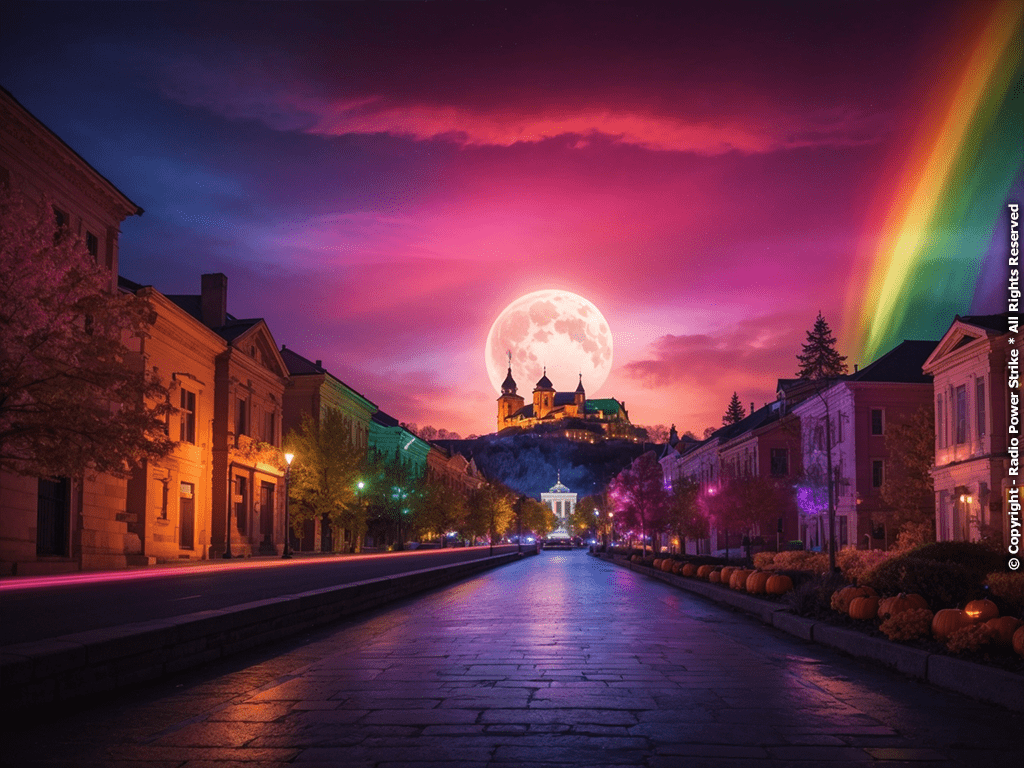The Queer Significance of Halloween: Celebrating Identity and Freedom
From Historical Safe Havens to Modern LGBTQIA+ Celebrations

Halloween, a festival of masks, mysteries, and imagination, has long been a canvas for individuals’ self-expression. For the LGBTQIA+ community, this celebration possesses deeper significance, symbolizing centuries of resilience, identity, and freedom. This article weaves together the stories of Halloween and queer celebrations, emphasizing the event’s role as a beacon of representation and liberation.
Halloween as a Safe Haven for Exploration
Historically, Halloween has transcended mere tales of the supernatural. It’s provided an annual gateway for self-discovery and expression, particularly for those within the LGBTQIA+ spectrum. The transformative power of masks and costumes has, over the years, offered many their first taste of genuine self-representation, albeit briefly.
The safety and anonymity that Halloween’s disguises provide have been invaluable. In a world rife with judgments and expectations, this festival has consistently been an oasis, allowing individuals to step out of the shadows and into the limelight, even if just for a night.
For many, especially those exploring their gender or sexual identity, Halloween has been a precursor to coming out. Personal accounts abound, painting a picture of solace, validation, and often the first spark of courage ignited by their experiences during this festive period.
The Complex Tapestry of Laws and Their Implications
Travel back to the 19th century, and one finds an era where laws often curbed gender expressions. Mandates, such as Columbus, Ohio’s 1848 rule against attire not aligned with one’s birth gender or New York City’s Masquerade Law, restricted fluid gender expressions.
Yet, within this restrictive tapestry, Halloween emerged as a beacon. It became a singular night where, under the guise of festivity, these laws were subtly sidestepped, giving many a fleeting taste of freedom.
This delicate dance between societal laws and personal identity accentuates Halloween’s significance as a refuge. It stands as a testament to the human spirit’s desire for self-expression, even in the face of adversity.

The Drag Connection
Drag, a vibrant tableau of gender performance and artistry, found an unexpected partner in Halloween. Long before drag performances became mainstream, Halloween offered a stage where drag artists could showcase their talents without fear of societal backlash.
This relationship between drag and Halloween isn’t just historical. Present-day events, like New York’s renowned Halloween parade, highlight the celebration’s deep roots in the LGBTQIA+ community, displaying an array of drag performers that capture the essence of both drag and Halloween’s transformative nature.
The synergy between drag and Halloween is more than coincidental. It’s a testament to society’s slow but steady evolution, recognizing and celebrating the myriad ways in which individuals choose to express themselves.
Halloween Ball Culture and Queer History
The shimmering world of ’70s and ’80s “ball culture”, predominantly helmed by Black and Latino queer communities, offers a fascinating chapter in the queer Halloween narrative. These extravagant balls, where fashion, dance, and identity converged, became particularly significant when infused with Halloween themes.
Events like the “Paris is Burning” ball stand at the intersection of Halloween’s themes of transformation and the LGBTQIA+ community’s emphasis on genuine representation. They became not just competitions but affirmations of identity, acceptance, and pride.
These balls, with their spectacle and heart, played a pivotal role in shaping contemporary LGBTQIA+ culture. They birthed iconic dance styles like voguing and symbolized the confluence of Halloween and the queer community’s resilience and spirit.
From Samhain to Now: An Evolution Intertwined with Queer Celebrations
Tracing Halloween’s origins leads us to Samhain, the ancient festival marking summer’s end. As traditions blended over centuries, Halloween emerged, entwined with spiritual beliefs and folklore. For the queer community, this evolution became an avenue for challenging norms, especially during the defiant 1920s.
The era witnessed a bold challenge to cross-dressing laws via Halloween drag balls. These events, popularized by figures like Alfred Finnie, gave birth to the term “gay Christmas”, echoing the sentiment of queer communities finding solace in Halloween’s embrace.
Today’s Halloween, while commercially different, still echoes the spirit of those early celebrations. It remains a tapestry of history, folklore, and the unyielding spirit of communities that sought acceptance and joy in its midst.
Modern Celebrations: A Fusion of Traditions
The contemporary world sees a seamless blend of traditional Halloween motifs with LGBTQIA+ pride celebrations. Cities globally orchestrate events that echo both the age-old allure of Halloween and the vibrant tapestry of queer culture.
This fusion is evident in events that merge Halloween’s transformative themes with the LGBTQIA+ community’s call for rights and recognition. These celebrations, attended by thousands, epitomize the intertwining narratives of Halloween and queer identity, highlighting their shared essence of transformation, recognition, and pride.
For many today, these events are more than just festive gatherings. They are symbols of a journey – one that has moved from the shadows of repression to the spotlights of acceptance and celebration.
Halloween’s essence stretches beyond its traditional festivities. For the LGBTQIA+ community, it symbolizes a journey from obscurity to recognition. As we embrace the masks and costumes every October 31st, it’s crucial to remember and celebrate the profound significance this day holds. It’s not just a festival; it’s an emblem of resilience, identity, and the timeless human quest for self-expression and acceptance.

Glossary
Lavender Scare
A period during the Cold War when federal employees were fired or denied employment because they were suspected of being homosexual, potentially making them vulnerable to blackmail by foreign agents.
Gender Non-conformity
Behaviors and appearances that do not align with societal expectations based on one’s assigned gender at birth.
Redface
The act of non-Indigenous individuals dressing up or portraying Indigenous people, often in stereotypical and offensive manners. Analogous to “blackface”.
Masquerade Law
Historic regulations that limited or forbade the wearing of masks or disguises in public, often targeted at specific groups or actions.
Three Article Law
An informal rule or law suggesting that individuals had to wear at least three items of clothing matching their assigned sex at birth to avoid arrest or harassment.
Ball Culture
A subculture originating in New York City, where predominantly Black and Latino LGBTQIA+ individuals would host balls. Participants would “walk” (perform) in various categories, from fashion to dance.
Samhain
An ancient Celtic festival marking the end of the harvest season and the beginning of winter. Believed to be a time when the boundary between the living and the deceased thinned, allowing spirits to pass through.
Frequently Asked Questions
Why is Halloween so significant in the LGBTQIA+ community?
Halloween has historically been a time of exploration and self-expression. For the LGBTQIA+ community, it has offered an opportunity to present authentic identities without the fear of societal backlash.
Are there other events similar to Halloween that allow such expression within the community?
While not exactly like Halloween, Pride events globally emphasize the celebration of identity and freedom of expression, although they focus more on community solidarity and political advocacy.
How can individuals support the LGBTQIA+ community during Halloween?
Showing respect for individual identities, avoiding cultural appropriation in costume choices, and promoting inclusive events are essential steps anyone can take.
What’s the significance of drag balls in the history of LGBTQIA+ celebrations?
Drag balls, primarily in the ’70s and ’80s, served as safe spaces for Black and Latino queer communities to celebrate fashion, dance, and self-expression. They played a pivotal role in shaping modern queer culture.
Are there other historical laws, similar to the Masquerade Law, that targeted LGBTQIA+ individuals?
Yes, throughout history, various regulations, both official and unofficial (like the “Three Article” rule), have been used to target and oppress LGBTQIA+ individuals based on their gender presentation or sexuality.
How have modern LGBTQIA+ Halloween celebrations evolved from their historical counterparts?
Modern celebrations often merge elements of traditional Halloween festivities with aspects of Pride, emphasizing both personal transformation and community solidarity.
Why is there an emphasis on avoiding cultural appropriation during Halloween?
Cultural appropriation trivializes and disrespects the traditions, symbols, and histories of marginalized groups. Given Halloween’s history as a space for marginalized expression, it’s especially important to avoid further marginalizing others during the celebration.

Comments are closed, but trackbacks and pingbacks are open.